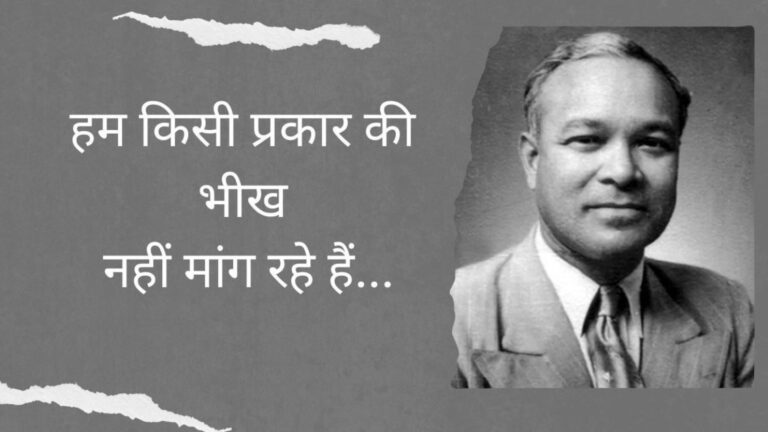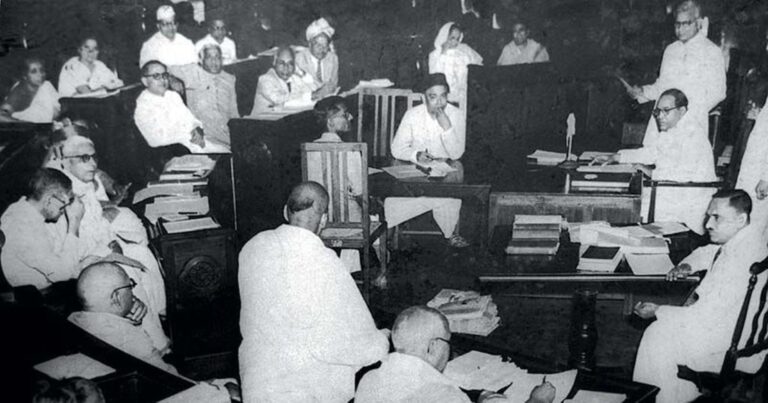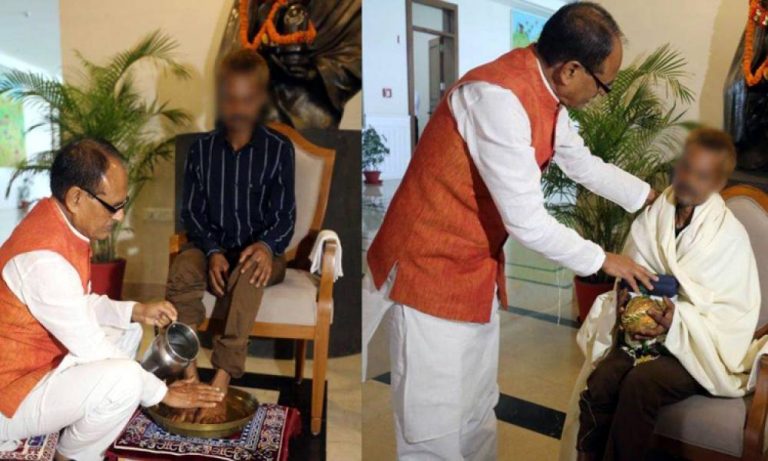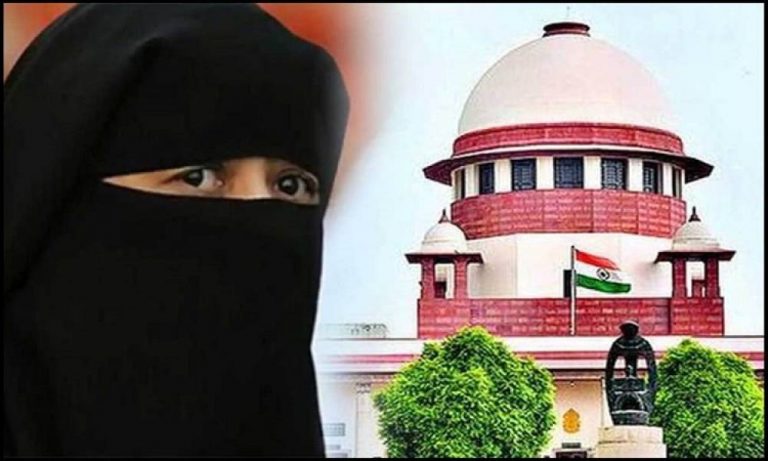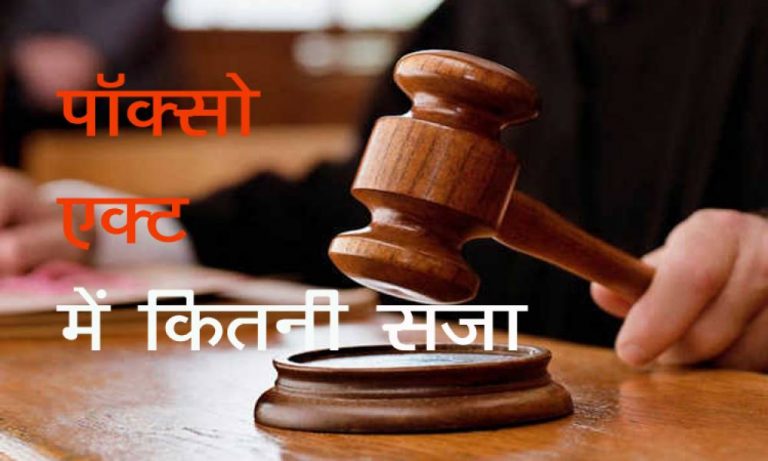ईडब्ल्यूएस को 10 फीसदी आरक्षण: दूर होगी असमानता?
सुप्रीम कोर्ट के नवंबर 2022 में आए फैसले में आर्थिक आधार पर 10 फीसदी आरक्षण दिए जाने के केंद्र सरकार के फैसले को बरकरार रखा गया है। सुप्रीम कोर्ट के पांच जजों की बेंच ने 3-2 के बहुमत से यह फैसला देते हुए में आर्थिक तौर पर कमजोर वर्ग (ईडब्ल्यूएस) को दिए जाने वाले 10 फीसदी आरक्षण को संवैधानिक रूप से वैध माना है। बहुमत के फैसले ने भेदभाव, अन्याय और असमानता को जाति के अलावा विभिन्न दृष्टिकोणों से देखने के लिए नई चर्चा के रास्ते खोल दिए हैं। इस फैसले के विभिन्न पहलुुओं पर यह विश्लेषण:
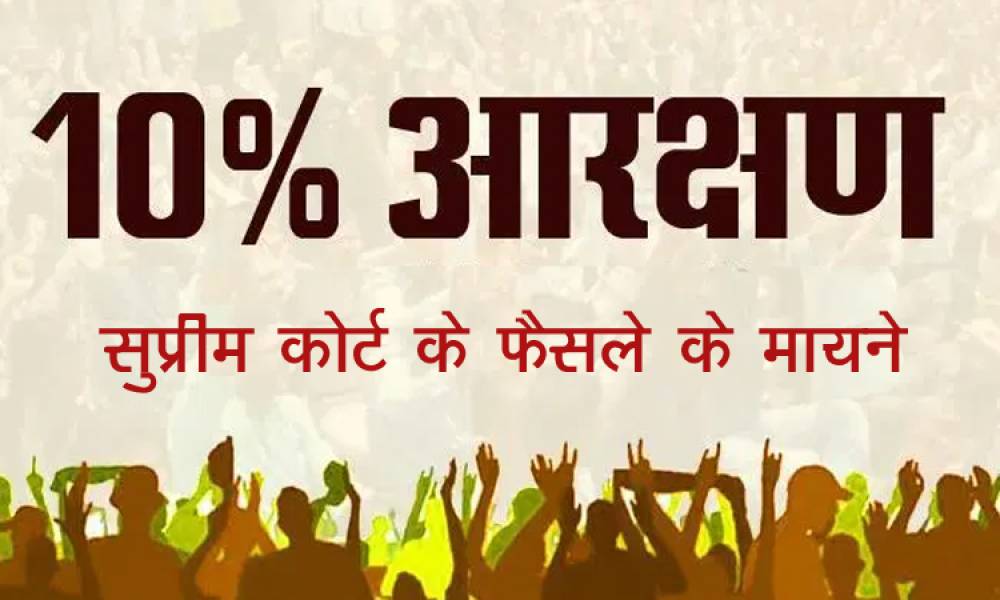

अमोल श्रीवास्तव
लेखक हाईकोर्ट इंदौर के अधिवक्ता तथा संविधान संवाद फेलो हैं।
सुप्रीम कोर्ट के नवंबर 2022 में आए फैसले में आर्थिक आधार पर 10 फीसदी आरक्षण दिए जाने के केंद्र सरकार के फैसले को बरकरार रखा गया है। सुप्रीम कोर्ट के पांच जजों की बेंच ने 3-2 के बहुमत से यह फैसला देते हुए में आर्थिक तौर पर कमजोर वर्ग (ईडब्ल्यूएस) को दिए जाने वाले 10 फीसदी आरक्षण को संवैधानिक रूप से वैध माना है। सुप्रीम कोर्ट ने इसके लिए संविधान में किए गए 103 वें संशोधन को सही ठहराया है। गौरतलब है कि इस संशोधन के क्षरा ईडब्ल्यूएस कैटेगरी को शिक्षण संस्थानों में दाखिले और सरकारी नौकरी में 10 फीसदी आरक्षण दिया गया है।
सुप्रीम कोर्ट के चीफ जस्टिस यूयू ललित, जस्टिस दिनेश महेश्वरी, जस्टिस बेला त्रिवेदी, जस्टिस जेबी पारदीवाला और जस्टिस एस रवींद्र भट्ट की पांच जजों की संवैधानिक बेंच ने यह फैसला दिया। जस्टिस महेश्वरी, जस्टिस त्रिवेदी और जस्टिस पारदीवाला ने आरक्षण के लिए संविधान संशोधन को बरकरार रखा और आरक्षण को सही ठहराया। वहीं चीफ जस्टिस ललित और जस्टिस भट्ट ने अल्पमत में आरक्षण के खिलाफ मत दिया। सुप्रीम कोर्ट की संवैधानिक पीठ ने हाल ही में 3:2 के बहुमत से सामाजिक, आर्थिक और शैक्षणिक रूप से पिछड़े वर्गों (एससी, एसटी) के लिए प्रदान किए गए आरक्षण के अलावा आर्थिक रूप से कमजोर वर्गों को 10% आरक्षण प्रदान करने वाले संविधान के 103वें संशोधन की वैधता को बरकरार रखा है। और ओबीसी) पहले संविधान के तहत प्रदान किया गया था।
फैसले पर बात करने के पहले पहले उन प्रावधानों की जानना उचित होगा जिन्हें चुनौती दी गई थी। 103 वें संवैधानिक संशोधन के माध्यम से अनुच्छेद 15 (6) और 16 (6) को पहले से मौजूद अनुच्छेद 15 और 16 में जोड़ा गया।1 उक्त संशोधन 14.01.2019 से लागू हुआ जब संसद ने अनुच्छेद 15 और 16 में संशोधन करते हुए दो नए खंड अर्थात अनुच्छेद 15 में स्पष्टीकरण के साथ खंड (6) और अनुच्छेद 16 में खंड (6) जोड़े थे। इस संशोधन से राज्य को “अनुसूचित जाति”, “अनुसूचित जनजाति” और “अन्य पिछड़ा वर्ग” के नॉन क्रिमिलेयर कैटेगरी के अलावा “आर्थिक रूप से कमजोर वर्गों” के नागरिकों के लिए अधिकतम दस प्रतिशत आरक्षण प्रदान करने का अधिकार मिल गया है।
दूसरे शब्दों में, संशोधन ऐसा प्रावधान है जो अनिवार्य नहीं है लेकिन राज्य और केंद्र सरकारों को ईडब्ल्यूएस के लिए आरक्षण प्रावधान करने में सक्षम बनाता है और इस आरक्षण की सीमा अधिकतम दस प्रतिशत निर्धारित करता है। यह आरक्षण एससी, एसटी और ओबीसी के आरक्षण के अतिरिक्त है और इन श्रेणियों को भी उक्त आरक्षण के लाभ से बाहर रखा गया है।
सुप्रीम कोर्ट के इस फैसले के विभिन्न पक्षों पर चर्चा के बाद यह प्रतीत होता है कि बहुमत से लिया गया यह निर्णय समानता, जातिविहीन और भेदभाव रहित समाज निर्माण के संवैधानिक लक्ष्यों की प्राप्ति के दृष्टिकोण को पूरा करने से जुड़ा है। इस फैसले के माध्यम से सुप्रीम कोर्ट ने यह विचार व्यक्त किया है कि संवैधानिक प्रावधानों और निर्देशों को इतने प्रतिबंधात्मक ढंग से लागू नहीं किया जा सकता है कि ऐतिहासिक अन्याय और जातिगत भेदभाव के सुधार के लिए किसी भी सकारात्मक कार्रवाई की अनुमति न दी जाए। संविधान राज्य को जाति आधारित आरक्षण के मौजूदा प्रावधानों के अलावा विभिन्न अन्य पिछड़े वर्गों के साथ असमानता और भेदभाव को अन्य मानदंडों पर पहचान और वर्गीकरण करने के लिए बाध्य करता है। बहुमत के फैसले ने भेदभाव, अन्याय और असमानता को जाति के अलावा विभिन्न दृष्टिकोणों से देखने के लिए नई चर्चा के रास्ते खोल दिए हैं और सामाजिक न्याय के अंग के रूप में सभी प्रकार की असमानता और भेदभाव को दूर करने के संवैधानिक लक्ष्य पर को प्राप्त करने पर बल दिया है। हालांकि, यह अभी भी देखा जाना बाकी है कि राज्यों द्वारा ईडब्ल्यूएस आरक्षण नीति कैसे लागू की जाएगी और यह नीति उस लक्ष्य को प्राप्त करने में कितनी सफल होगी। 10 फीसदी आरक्षण का यह प्रावधान वास्तव में अपने वादों को पूरा करता है या समानता का लक्ष्य पाने के बदले अधिक वर्ग विभाजन पैदा करता है, यह तय करने के लिए ईडब्ल्यूएस आरक्षण की अर्हता के मानदंड और मानक तय करना एक बहुत महत्वपूर्ण कारक होगा।
यह आलेख मूलतः अंग्रेजी भाषा में है और इस आलेख में इन्हीं सब बिन्दुओं पर विस्तार से चर्चा की गई है। संपूर्ण आलेख इस प्रकार है:
A pragmatic change in the understanding of reservation under the Constitution.
Recently the constitutional bench of the Supreme Court by way 3:2 majority upheld the legality and validity of Constitution 103rd amendment providing 10% reservation to economically weaker sections in addition to the reservation provided for socially, economically and educationally backward classes (SCs, STs, and OBCs) previously provided under the constitution.
Before reverting to the judgment it will be appropriate to examine the provisions which were under challenge. By way of constitutional 103rd amendment Articles 15(6) and 16(6) were added to the pre-existing Articles 15 and 16. The said amendments which came into effect on 14.01.2019, whereby the parliament has amended Articles 15 and 16 of the Constitution of India by adding two new clauses viz., clause (6) to Article 15 with Explanation and clause (6) to Article 16; and thereby, the State has been empowered, to provide for a maximum of ten per cent. reservation for “the economically weaker sections” of citizens other than “the Scheduled Castes”, “the Scheduled Tribes” and the non-creamy layer of “the Other Backward Classes”.
In other words the amendment is an enabling provision does not mandate but enables the State and Central Governments to provide for reservation for EWS by the states and prescribes a ceiling limit of ten per cent. This reservation is in addition to the reservation of SC, STs and OBCs and these categories are also kept out of the benefit of the said reservation.
The amendment under Article 15(6) enables the State to make special provisions for the advancement of any economically weaker section of citizens, including reservations in educational institutions. It states that such reservations can be made in any educational institution, including both aided and unaided private institutions, except minority educational institutions covered under Article 30(1). It further states that the upper limit of EWS reservations will be 10% (meaning up to 10% of seats can be reserved for citizens falling in the EWS category). This 10% ceiling is independent of ceilings on existing reservations.
Article 16(6) enables the State to make provisions for reservation in appointments. Again, these provisions will be subject to a 10% ceiling, in addition to the existing reservations.
More than 20 petitions were filed challenging the constitutional validity of the 103rd Amendment. The petitioners argued that the Amendment violates the basic features of the Constitution and violates the fundamental right to equality under Article 14. In particular, they make the following arguments:
1. Reservations cannot be based solely on economic criteria, given the Supreme Court’s judgment in Indra Sawhney v. Union of India (Mandal Commission case)
2. SCs/STs and OBCs cannot be excluded from economic reservations, as this would violate the fundamental right to equality.
3. The Amendment introduces reservations that exceed the 50% ceiling-limit on reservations, established by Indra Sawhney.
4. Imposing reservations on educational institutions that do not receive State aid violates the fundamental right to equality.
Issues framed by the bench for determination were as follows:
(1) Whether the 103rd Constitution Amendment can be said to breach the basic structure of the Constitution by permitting the State to make special provisions, including reservation, based on economic criteria?
(2) Whether the 103rd Constitution Amendment can be said to breach the basic structure of the Constitution by permitting the State to make special provisions in relation to admission to private unaided institutions?
(3) Whether the 103rd Constitution Amendment can be said to breach the basic structure of the Constitution in excluding the SEBCs/OBCs/SCs/STs from the scope of EWS reservation?
(4) Whether the cap of 50% referred to in earlier decisions of the Supreme Court can be considered to be a part of the basic structure of the Constitution? if so, can the 103rd Constitution Amendment be said to breach the basic structure of the Constitution?
On September 27th, 2022, the Supreme Court finished hearing arguments from all the parties and reserved Judgment in the case. In a 3:2 split, the Bench delivered the Judgment on November 7th, 2022 and declared that the Amendment and EWS Reservations were constitutionally valid. Justices Maheshwari, Trivedi and Pardiwala wrote separate concurring opinions for the majority and Justice Bhat wrote a dissent on behalf of himself and Chief Justice U.U. Lalit.
Arguments by petitioners:
On behalf of the petitioners it was submitted that the basic structure of the Constitution has been violated by the amendment in question which seeks to empower the privileged sections of society, who are neither socially and educationally backward nor inadequately represented. The amendment in question has introduced those section of people as economically weaker who were never subjected to any discrimination, whether historically or otherwise; and were not backward, socially and educationally and as such the same is impermissible under the Constitution which provided reservation only to socially, educationally and economically backward classes and not economically backward alone.
It was further stated that exclusion of disadvantaged class (SC, ST and OBC) from the protection and benefit of economic reservation violate the basic structure of the Constitution. It was argued that such exclusion of SCs, STs and OBCs was primarily based on caste because it is indeed undisputed that a large chunk of population so excluded are also economically backward along with being socially and educationally backward. Hence, the basic principle of equality forming the basic structure of the Constitution is violated by excluding those who are socially and educationally backward and also are part of systemic poverty/labour under abject poverty.
It was argued that the general category communities, for whose benefit the amendment is intended, are duly represented in all walks of life and hence, even from the angle of adequacy in representation, they are not eligible to avail benefit of reservation under Articles 15 and 16.
In the amendment in question, the economic criteria is the sole basis for grant of reservation without considering the concept of representation; the newly protected class under the amendment in question lacks historic and continuing lack of adequate representation caused by structural or institutional barriers, so as to be eligible for positive discrimination. In other words lack of representation is a main criteria for providing reservation under Article 14 which is not fulfilled.
Further, the reservation is intended to be operative only until there is inadequacy in representation of those classes and not in perpetuity. However, the present amendment prescribes essentially no end to reservation as there would always be people poorer than others. Since the need for reservation has been delinked from inadequacy of representation and the need to show backwardness, there is no natural guardrail or end point to reservations connected with poverty. This constitutes a clear violation of the Equality Code and of the basic structure of the Constitution. Even if we were to accept poverty and income as valid criteria for the grant of reservation then too, the amendment to the extent of ‘other than the class mentioned in clause (4) and (5)’ should be severed from Articles 15(6) and 16(6) so as to include the poor of all classes without any exclusion or discrimination
Reference was made to the Constituent Assembly Debates to contend that the Assembly was of the clear opinion that the word ‘backward’ should precede ‘class of people’. Therefore, despite being aware of the rampant poverty in the country, the focus of reservations was predominantly on the social stigma attached to the group. Reservation in public employment was given because the framers wanted the backward classes to share State power and for that matter, they had to be provided equal opportunity. The Assembly intended to extend the benefits of affirmative action to only those socially and educationally backward groups who had been excluded from mainstream national life due to historic injustice, stigma and discrimination and thus, bringing in any other criteria, excluding the communities who have suffered such stigmatisation, would be a blatant violation of not only the Equality Code but also the very principles of democracy (sharing of power being necessary to sustain democracy), both of which form part of the basic structure of the Constitution.
It was also argued that the criteria for ‘backwardness’ was always ‘social’ in nature and ‘economic’ backwardness was never accepted as the sole criteria. Even in the case of Indra Sawhney Vs. Union of India (Mandal Commission case), it was contended that by the majority of 8:1, it was held that economic criteria cannot be the sole basis to grant reservation under Article 16. That reservation solely on economic criteria would violate the principles of substantive equality ingrained in the Constitution, which was directed against identity-based historic marginalisation. In Indra Sawhney it has been held that economic criteria cannot be the sole basis to provide reservation.
That, the amendment in question violates the Equality code because, if poverty is the rationale behind it and it aims at providing jobs for the poor by way of reservation then, the amendment fails to address as to how the poverty of the forward class is different from that of the SCs, STs and OBCs and the said categories could not have been excluded from this reservation. Hence, the amendment in question fails the test of rationality and violates the basic structure of Constitution. In our society, discrimination finds its root in caste, religion, race, etc. and not in economic condition of a person as per the petitioners.
On the extent of reservation, it was submitted that the amendment providing reservation “in addition to existing reservation” breaches the fifty per cent. ceiling limit, which is now not only a part of constitutional interpretation of reservation provisions but is also a part of basic structure of the Constitution. It was emphasised that in more than 54 judgments of the Supreme Court including the 9 judge bench case of Indra Sawhney the ceiling limit of 50% has become an absolute rule which cannot be breached. This ceiling limit must be maintained when reservations are activated while interpreting Articles 15 and 16, and hence has become a part of basic structure of constitution.
Arguments by Respondents:
Attorney General of India argued that the 103rd Amendment does not violate the basic structure of the Constitution, rather fosters it. Second, the exclusion of those classes already covered under Articles 15(4) and 16(4) from the proposed reservation did not breach the Equality Code. Third, the fifty per cent. limit is not a sacrosanct rule. Lastly, the benefit to EWS with respect to admission in private aided or unaided educational institutions does not violate Article 14.
It was submitted that in M. Nagaraj Vs. Union of India (reservation in promotions case), as to dynamic interpretation of the Constitution to strengthen its Preambular vision; and has submitted that Articles 38 and 46 along with Preamble to the Constitution enjoin a duty on the State to eliminate social, economic and political inequalities and to promote justice. He has further argued that this Court has, over the years, repeatedly recognised that it was desirable to use poverty as the only basis for affirmative action and that it is poverty or economic deprivation that results in social and educational backwardness. It was submitted that the creation of new class fosters the vision of ‘Economic Justice’, as set out in the Preamble, hence strengthening the basic structure of the Constitution.
It was contended that the exclusion of already covered classes does not violate Equality Code as the EWS among the SC, ST and OBC communities are already enjoying the benefit of affirmative action in their favour by way of reservations in educational institutions and public employment, seats in Legislature, etc., to attain an equal status – socially and educationally.
As to the extent of reservation, it was submitted that the fifty per cent. cap as laid down in Indra Sawhney is for the classes covered under Articles 15(4), 15(5) and 16(4). Therefore, extending the benefit of 10 % to these classes would exceed the reservation made for them beyond 50%, and that would be violative of Indra Sawhney. He has also contended that this 50% rule could be breached in extraordinary situation, as held by Indra Sawhney; and is, therefore, not an inviolable rule or part of the basic structure of the Constitution.
He would submit that a constitutional amendment may even touch upon the basic structure but unless it is shown that it fundamentally alters the basic structure or basic features of the Constitution, it cannot be struck down under judicial review. He has further argued that the amendment in question, instead of hitting or disturbing the basic structure, rather strengthens the Preambular vision of the Constitution i.e., of providing economic justice to its people along with social and political justice.
FINDINGS OF THE COURT:
Majority judgment upholding the amendment has held that the EWS reservation amendment does not violate the basic structure of the Constitution, the amendment does not violate equality principle under Article 14, by excluding SC, STs, OBCs and SEBCs from the EWS reservation, nor does violate 50% ceiling limit, in the majority judgment Justice Dinesh Maheswari held:
• The insertion of these amended provisions, is primarily to be regarded as a part of the frontal efforts to eradicate poverty ‘in all its forms everywhere’. The only question is as to whether providing for economic criteria as the sole basis for reservation is a violation of the basic structure of the Constitution. A simple reading of the heading together with the contents would make it clear that the broader expression “other weaker sections” in Article 46 is separated from the particular weaker sections (Schedule Castes and Scheduled Tribe); and is not confined to only those sections who are similarly circumstanced to SCs and STs. According to the court the amendment in question is essentially related to the requirements of those economically weaker sections who have not been given the benefit of such an affirmative action (particularly of reservation), which was accorded to the other class/classes of citizens namely, the SEBCs /OBCs/SCs/STs. Viewing this action of EWS reservation from the standpoint of backward class versus forward class is not in accord with the very permissibility of compensatory discrimination towards the goal of real and substantive justice for all.
• In respect of the third issue regarding exclusion of SC STs and OBCs from the economic reservation, it was held that EWS reservation itself is another form of compensatory discrimination, which is meant for serving the cause of such weaker sections who have before not been given any State support by way of reservation. SEBCs/OBCs/SCs/STs are having the existing compensatory discrimination in their favour wherein the presently supported EWS are also excluded alongwith all other excluded classes/persons. Thus when EWS is to be given support by way of compensatory discrimination, that could only be given by exclusion of others, and more particularly by exclusion of those who are availing the benefit of the existing compensatory discrimination in exclusion of all others. Put in simple words, the exclusion of SEBCs/OBCs/SCs/STs from EWS reservation is the compensatory discrimination of the same species as is the exclusion of general EWS from SEBCs/OBCs/SCs/STs reservation. The fact that exclusion is necessary for compensatory discrimination could further be exemplified by the fact that in Indra Sawhney case, this Court excluded the creamy layer of OBCs from the benefit of reservation. In the complex set-up of formal equality on one hand (which debars discrimination altogether) and real and substantive equality on the other (which permits compensatory discrimination so as to upset the disadvantages), exclusion is as indispensable as the compensatory discrimination itself is. In fact, ‘creamy layer’ principle itself was applied to make a true compact of socially and educationally backward class.
• The majority view addresses the issue in a negative manner. If the rule is inviolable, classes already in the fifty percent cannot stake claim in the EWS quota. The ceiling limit of 50% therefore does not get breached.
Two Hon’ble judges Hon’ble Bela M. Trivedi, J. and Hon’ J.B. Pardiwala, J. concurred with the judgment of Justice Maheshwari, but gave further reasons for upholding the amendments. The observations of these judges reveal that they have taken a more pragmatic view of the issue, and have handled the issue of reservation as an evolving concept from a constitutional point of view. They have supported the theory of the Constitution to be a living and evolving document which has to progress from the perspective of time and other social changes. The constitutional principles have to mould themselves to these changes to serve the constitutional goals, rather than fixed principles and norms which may not be relevant in the changing times.
Some observations of these judges are highlighted hereunder, which signify such a change in approach to deal with the issue of reservation are as follows:
• It was observed that in this country with a population of around 1.41 billion, the economic backwardness is not confined only to those who are covered by Article 15(4) or Article 16(4) of the Constitution. In a country where only a small percentage of the population is above the poverty line, to deny opportunities of higher education (which secures employment) and employment is to deny to those who are qualified and deserving what is or at least should be their due.
• What was envisioned by the framers of the Constitution, what was proposed by the Constitution Bench in 1985 and what was sought to be achieved on the completion of fifty years of the advent of the Constitution, i.e. that the policy of reservation must have a time span, has still not been achieved even till this day, i.e. till the completion of seventy-five years of our Independence. It cannot be gainsaid that the age-old caste system in India was responsible for the origination of the reservation system in the country. It was introduced to correct the historical injustice faced by the persons belonging to the scheduled castes and scheduled tribes and other backward classes, and to provide them a level playing field to compete with the persons belonging to the forward classes. However, at the end of seventy-five years of our independence, we need to revisit the system of reservation in the larger interest of the society as a whole, as a step forward towards transformative constitutionalism. Be it noted that under the Constitution, the provisions of the Constitution relating to the reservation of seats for the SCs and the STs in the House of the People and in the Legislative Assemblies of the States would cease to have effect on the expiration of a period of eighty years from the commencement of the Constitution. The representation of Anglo-Indian community in the House of the Parliament and in the Legislative Assemblies of the States by nomination, has already ceased by virtue of the 104 th Amendment w.e.f. 25.01.2020. Therefore, similar time limit if prescribed, for the special provisions in respect of the reservations and representations provided in Article 15 and Article 16 of the Constitution, it could be a way forward leading to an egalitarian, casteless and classless society.
• The impugned amendment creates a separate class of “economically weaker sections of the citizens” from the general/unreserved class, without affecting the special rights of reservations provided to the Scheduled Caste/Scheduled Tribe and backward class of citizens covered under Article 15(4), 15(5) and 16(4). Therefore, their exclusion from the newly created class for the benefit of the “economically weaker sections of the citizens” in the impugned amendment cannot be said to be discriminatory or violative of the equality code.
• The natural effect of reservation is to close the door of betterment or even employment to even a portion of economically weak section of community. This all the more emphasises the urgent necessity of eliminating or at least substantially reducing the causes which have contributed to the creation of socially and educationally backward section of the community, thus, creating a situation when the need of reservation would be no more. Then alone the promise of equality for all would become a reality. And, it is to be remembered that right of equality is the “Cornerstone of the Constitution”.
• The State, therefore, cannot blind itself to the existence of other forms and instances of backwardness. An affirmative action policy that keeps in mind only historical injustice would certainly result in under protection of the most deserving backward class of citizens, which is constitutionally mandated. It is the identification of these new emerging groups that must engage the attention of the State and the constitutional power and duty must be concentrated to discover such groups rather than to enable groups of citizens to recover “lost ground” in claiming preference and benefits on the basis of historical prejudice.”
• Economic capacity has been upheld as a valid basis for classification by this Court in various other contexts. It has also been implored to be considered as a relevant facet of the ‘Equality Code’ provisions. The 103rd Amendment offers a basis not contrary to Article 15(1) or 16(2) for providing a population generic and caste/religion/community neutral criteria. It also harmonizes with the eventual constitutional goal of a casteless society.
• The words “weaker sections” used in Article 46 cannot be read to mean only the Scheduled Castes or the Scheduled Tribes. The expression refers to all weaker sections and in particular the Scheduled Castes and the Scheduled Tribes. Inasmuch as, if we confine the meaning of the expression “weaker sections” only to the Scheduled Castes or the Scheduled Tribes or the likes, namely backward class, then it will expose the weaker sections of citizens, other than the Scheduled Castes and the Scheduled Tribes and backward class people to exploitation without any protection from it.
• Thus, it is evident from the aforesaid that there can be reservation for certain weaker sections other than the SCs/STs and socially and educationally backward classes. The impugned amendment is meant for weaker sections of the society who are economically weak and cannot afford to impart education to their children or are unable to secure employment in the services of the State.
• The reservation is not an end but a means to secure social and economic justice. Reservation should not be allowed to become a vested interest. Real solution, however, lies in eliminating the causes that have led to the social, educational and economic backwardness of the weaker sections of the community. This exercise of eliminating the causes started immediately after the Independence i.e., almost seven decades back and it still continues. The longstanding development and the spread of education have resulted in tapering the gap between the classes to a considerable extent. As larger percentages of backward class members attain acceptable standards of education and employment, they should be removed from the backward categories so that the attention can be paid toward those classes which genuinely need help. In such circumstances, it is very much necessary to take into review the method of identification and the ways of determination of backward classes, and also, ascertain whether the criteria adopted or applied for the classification of backward is relevant for today’s conditions. The idea of Baba Saheb Ambedkar was to bring social harmony by introducing reservation for only ten years. However, it has continued past seven decades. Reservation should not continue for an indefinite period of time so as to become a vested interest.
Now, coming to the minority view of Chief Justice UU Lalit and Justice Ravindra Bhatt, they held the impugned amendment to be unconstitutional and violative of Articles 14. A few points may be worth noting:
• It was said that what is described as benefits by the Union cannot be understood to be a free pass, but as reparative mechanism to have a level playing field. Their exclusion discriminates equality code and violates basic structure.
• “Reservation is contrary to the essence of equal opportunity. The 103rd amendment practices prohibited forms of discrimination,”
• It was also noted that the bulk of economically weaker sections belong to SCs and OBCs, therefore exclusion of these grounds from EWS reservation is not justified. Reservation through economic criteria per se not violative. Reservation has been provided to historically disadvantaged cannot be basis to contain other disadvantaged groups unable to progress and say that provision can’t be made for EWS through amendment. Reservation through economic criteria per se not violative, but exclusion of backward classes violative of basic structure.
• Reservations were conceived and quotas created to offset deep-rooted wrongs on communities and castes.
• “Reservations designed as powerful tool to enable equal access. Introduction of economic criteria and excluding other backward classes ,SC, ST, OBC, saying they had these pre-existing benefits is injustice.
• It was held that the exclusionary clause operates in utterly arbitrary manner, as well as against socially disaffected castes by confining them within their quotas and it denies chance of mobility from reserved quota based on past discrimination to reservations under economic criteria. Impugned amendment and classification it creates is arbitrary, results in discrimination,
For these reasons, minority judgment struck down article 15(6) and 16(6) and held them to be violative of equality code, particularly for violating principles of non-discrimination and non-inclusion which form part of basic structure. The said view subscribes to traditional understanding of the concept of reservation to be restricted to caste alone.
Conclusions:
From the aforesaid discussion it appears that the majority judgment deals with reservation from the point of view achievement of eventual constitutional goals of equality, casteless and discrimination less society. It holds that the constitutional provisions and directives cannot be read so restrictively so as to not permit any affirmative action other than for correction of historic injustice and caste discrimination. The constitution obligates the State to identify and classify various other backward classes and grounds of discrimination on criterias other than provided under the current provisions of caste based reservation. The majority judgment has opened up new discussions and avenues to view discrimination, injustice and equality from various perspectives other than caste and has highlighted the constitutional goal of removal of all forms of inequality and discrimination as a part of social justice. However, it still remains to be seen how the EWS reservation policy will be enacted by the States and how far it would go to achieve that goal. Fixing of proper criteria and parameters to qualify for EWS reservation would be a very important factor in deciding whether the said provision actually fulfils its promises or just further creates class divisions without actually achieving anything.
References:
1. Article 15(6): Nothing in this article or sub-clause (g) of clause (1) of Article 19 or clause (2) of Article 29 shall prevent State from making:
(a) any special provision for the advancement of any economically weaker sections of citizens other than the classes mentioned in clauses (4) and (5); and
(b) any special provision for the advancement of any economically weaker sections of citizens other than the clauses mentioned in clauses (4) and (5) insofar as such special provisions relate to their admissions to educational institutions including private educational institutions, whether aided or unaided by the State, other than the minority educational institutions referred to in clause (1) of Article 30, which in the case of reservation would be in addition to the existing reservations and subject to a maximum of ten per cent of the total seats in each category.
Explanation.—For the purpose of this article and Article 16, “economically weaker sections” shall be such as may be notified by the State from time to time on the basis of family income and other indicators of economic disadvantages.
Article 16(6): Nothing in this article shall prevent the State from making any provision for the reservation of appointments or posts in favour of any economically weaker sections of citizens other than the classes mentioned in clause (4), in addition to the existing reservation and subject to a maximum of ten per cent of the posts in each category.
2. 38. State to secure a social order for the promotion of welfare of the people
(1) The State shall strive to promote the welfare of the people by securing and protecting as effectively as it may a social order in which justice, social, economic and political, shall inform all the institutions of the national life
(2) The State shall, in particular, strive to minimize the inequalities in income, and endeavor to eliminate inequalities in status, facilities and opportunities, not only amongst individuals but also amongst groups of people residing in different areas or engaged in different vocations.
46. Promotion of educational and economic interests of Scheduled Castes, Scheduled Tribes and other weaker sections The State shall promote with special care the educational and economic interests of the weaker sections of the people, and, in particular, of the Scheduled Castes and the Scheduled Tribes, and shall protect them from social injustice and all forms of exploitation.
3. Socially and economically backward classes.

